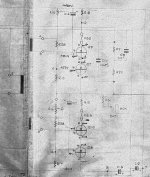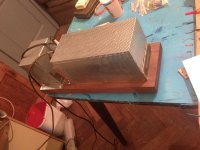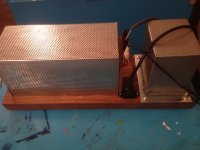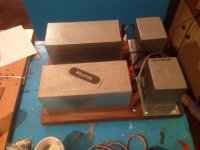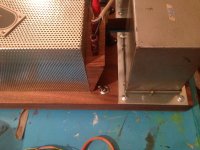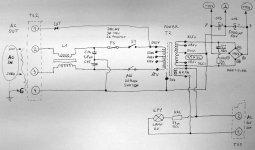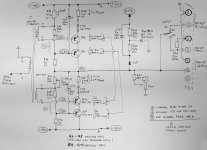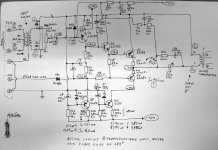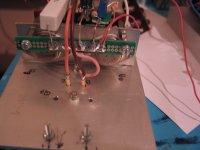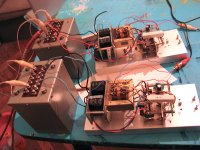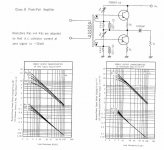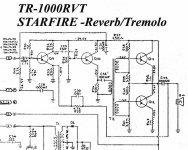Hi
I repaired old Germanium amplifier. Westrex model 2404-C. I had these 2 pieces for years. And original blueprint too. Left only output stages. This is the very simple, 4 power germanium transistor amp.
Used only original parts (except box). I replaced only 1 resistor because of the un-dimensioned power dissipated too much. And add one multi-turn pot for off-sett voltage adjust.
I repaired old Germanium amplifier. Westrex model 2404-C. I had these 2 pieces for years. And original blueprint too. Left only output stages. This is the very simple, 4 power germanium transistor amp.
Used only original parts (except box). I replaced only 1 resistor because of the un-dimensioned power dissipated too much. And add one multi-turn pot for off-sett voltage adjust.
Original sch. Not much of the quality scan, probably because it is big blueprint?
But I will post re-drawed too.
I cut only the output stage from the original sch... It is too big. (If someone wants all original sch please pp)
But I will post re-drawed too.
I cut only the output stage from the original sch... It is too big. (If someone wants all original sch please pp)
Attachments
Forgot to say that I replaced original PS Cs too. Because they are pretty old, (but working)
I put new Elna's but the same value of "only" 4700uF/50V. I didn't want to place higher value of power C because I think that will change original sound. And because of the huge power transformer.
Amps are ultra quiet, transformers are totally quiet and without any vibrations when operate. It is hard to estimate is the amps are on or off with ear on the speaker 🙂
...
I was doubt about off-set holding, and was wrong - these amps are holding zero or close to zero mV at loudspeker, very stable and good. 🙂
I put new Elna's but the same value of "only" 4700uF/50V. I didn't want to place higher value of power C because I think that will change original sound. And because of the huge power transformer.
Amps are ultra quiet, transformers are totally quiet and without any vibrations when operate. It is hard to estimate is the amps are on or off with ear on the speaker 🙂
...
I was doubt about off-set holding, and was wrong - these amps are holding zero or close to zero mV at loudspeker, very stable and good. 🙂
Very nice! Good to see this old gear live another day.
I have restored some germanium amps inside of console stereo and have been happy with the results. Nothing as fancy as this Westrex.
I have restored some germanium amps inside of console stereo and have been happy with the results. Nothing as fancy as this Westrex.

few photos more. I cut out long wire traces. Leave original WE wire which is surprisingly in good condition. Even found a some vintage speaker outputs. Power wiring is under the wood.
...
I think That this topology deserves some work on.
- Maybe Germanium Darlington should be make against every singlepower Q? That will decrease current to the input transformer secondaries, even the currents are canceling, this cancelation with Darlingtons will be smaller...
...
- Output Transformer should be added. To step down for lover Zspeaker and 1:1 for 16ohm. It is not compicated because almost no DC offset is stable, And low source resistance. So the design is almost simple, no need for mucho Hy, thick wire, good isolation...
...
- And bit better input Transformer. Inspired of sound is pretty good with original interstager. I measured few decades of MHy only. So it is indicating that only lower resistance source is acceptable for proper BW low end.
...
- Probably some buffer input stage and preferably Germanium too. 🙂
...
I think That this topology deserves some work on.
- Maybe Germanium Darlington should be make against every singlepower Q? That will decrease current to the input transformer secondaries, even the currents are canceling, this cancelation with Darlingtons will be smaller...
...
- Output Transformer should be added. To step down for lover Zspeaker and 1:1 for 16ohm. It is not compicated because almost no DC offset is stable, And low source resistance. So the design is almost simple, no need for mucho Hy, thick wire, good isolation...
...
- And bit better input Transformer. Inspired of sound is pretty good with original interstager. I measured few decades of MHy only. So it is indicating that only lower resistance source is acceptable for proper BW low end.
...
- Probably some buffer input stage and preferably Germanium too. 🙂
Attachments
I measure pretty good BW, without global feedback, low end is less than -0.4db@20Hz
high is -1.6db cca @20KHz
Sound is very very good, with naturality of voices, exeptional foundation of tone, instruments and voices too, and solid base.
high is -1.6db cca @20KHz
Sound is very very good, with naturality of voices, exeptional foundation of tone, instruments and voices too, and solid base.
Very nice! Good to see this old gear live another day.
I have restored some germanium amps inside of console stereo and have been happy with the results. Nothing as fancy as this Westrex.
Yes
Unfortunatly I dont have pictures of original packages. They are used as mono block racks, point to point wiring (no pcbs) for film industry studio department. These amps was drivers for also Western Electric Cabinets. (I am listening now horn units, while 15in LF units are resting... I will open another topic in Speakers to show speaker modules soon)
.
cheers 🙂
Thanks. Of course Westrex was the UK arm of Western Electric and they made some amazing gear. Nice to hear that your getting good sound out of such a simple transistor design. My consoles are similar, with interstage transformers.
Would love to see more photos.
Would love to see more photos.
Congratulations on restoring such a nice unit.
Personally I would not "improve the design" but respect original one, just replacing aged *parts* such as electrolytics.
Personally I would not "improve the design" but respect original one, just replacing aged *parts* such as electrolytics.
...Of course Westrex was the UK arm of Western Electric....
Westrex was the talking-pictures division of W.E., and mostly worked in the US, Hollywood, though sold and serviced any place movies could talk. As the UK made and showed good talkies they would have an organization there, but a bud on the US head.
Western Electric is much older, originally from Chicago, though best known from Hawthorn NJ.
W.E. worked closely with Bell Telephone System. In telephony if you have one bad joint you have millions of bad joints. W.E. stuff was obsessively well-detailed to control TCO.
Bell and WE basically invented "all of audio". As innovators with hard commercial experience they tended to build prototypes "as good as they knew how". And in the quickly growing talking-movie racket most products were made in short runs right from the prototypes.
Westrex faded from the theater business in part because they did not build the better systems MGM wanted for big sound in many theaters. Bell Labs had suitable prototypes but maybe they were too expensive, or maybe MGM did not want to pay the price (both money and implied single-source). RCA and others got in with other products (the fight between vari-area and vari-density sound tracks). L.A. was full of radio-techs who could take a WE product and do it cheaper. But the Westrex or WE name appears on many films past mid-century.
I would not change a thing on that antique schematic, except omit (and hoard or sell) the input transformer. The 5K pot is a perfectly fine input for modern hi-fi work.
Very nice! Good to see this old gear live another day.
I have restored some germanium amps inside of console stereo and have been happy with the results. Nothing as fancy as this Westrex.
Which model if You remember?
Congratulations on restoring such a nice unit.
Personally I would not "improve the design" but respect original one, just replacing aged *parts* such as electrolytics.
Yes. I agree. That is what i did.
I probably didn't be specific... Sorry. I do not want to improve this particular devices. Because they are already working well and they are with original parts.
I meant to design some other piece based on this concept. And slightly maybe improve some parts that I point earlier?
Because we still have available older Germanium power devices NOS. And the things with this design are more simple because it use 4 devices from same part. 🙂
Last edited:
Westrex was the talking-pictures division of W.E., and mostly worked in the US, Hollywood, though sold and serviced any place movies could talk. As the UK made and showed good talkies they would have an organization there, but a bud on the US head.
Western Electric is much older, originally from Chicago, though best known from Hawthorn NJ.
W.E. worked closely with Bell Telephone System. In telephony if you have one bad joint you have millions of bad joints. W.E. stuff was obsessively well-detailed to control TCO.
Bell and WE basically invented "all of audio". As innovators with hard commercial experience they tended to build prototypes "as good as they knew how". And in the quickly growing talking-movie racket most products were made in short runs right from the prototypes.
Westrex faded from the theater business in part because they did not build the better systems MGM wanted for big sound in many theaters. Bell Labs had suitable prototypes but maybe they were too expensive, or maybe MGM did not want to pay the price (both money and implied single-source). RCA and others got in with other products (the fight between vari-area and vari-density sound tracks). L.A. was full of radio-techs who could take a WE product and do it cheaper. But the Westrex or WE name appears on many films past mid-century.
I would not change a thing on that antique schematic, except omit (and hoard or sell) the input transformer. The 5K pot is a perfectly fine input for modern hi-fi work.
Thanks for additional informations 🙂
The power section's designs is quite uncommon: At first glance it appears the devices are put in series that they can cope with the rail voltages, which might be beyond one device's VCEO. But if we look closer we discover two cascodes! Why did they do so, as a cascode's highish output impedance is counter-productive?
Best regards!
Best regards!
Probably cascode because of the stability? I am mostly from tube world, (maybe little jfet too)...😀
I have some other examples employing same type of transformer sort of phase spliting.
I have some other examples employing same type of transformer sort of phase spliting.
Attachments
Transformer phase splitting isn't the point, as it was quite common in the early days of »ironless« amplifiers with transistors. It's the cascodes that do puzzle me.
Best regards!
Best regards!
Germanioum power devices inside are NKT401 like stated at original sch.
.
Type Designator: NKT401
Material of Transistor: Ge
Polarity: PNP
Maximum Collector Power Dissipation (Pc): 50 W
Maximum Collector-Base Voltage |Vcb|: 90 V
Maximum Collector-Emitter Voltage |Vce|: 60 V
Maximum Emitter-Base Voltage |Veb|: 40 V
Maximum Collector Current |Ic max|: 10 A
Max. Operating Junction Temperature (Tj): 90 °C
Transition Frequency (ft): 0.2 MHz
Collector Capacitance (Cc): 250 pF
Forward Current Transfer Ratio (hFE), MIN: 225
Noise Figure, dB: -
Package: TO3
.
Type Designator: NKT401
Material of Transistor: Ge
Polarity: PNP
Maximum Collector Power Dissipation (Pc): 50 W
Maximum Collector-Base Voltage |Vcb|: 90 V
Maximum Collector-Emitter Voltage |Vce|: 60 V
Maximum Emitter-Base Voltage |Veb|: 40 V
Maximum Collector Current |Ic max|: 10 A
Max. Operating Junction Temperature (Tj): 90 °C
Transition Frequency (ft): 0.2 MHz
Collector Capacitance (Cc): 250 pF
Forward Current Transfer Ratio (hFE), MIN: 225
Noise Figure, dB: -
Package: TO3
- Status
- Not open for further replies.
- Home
- Amplifiers
- Solid State
- Westrex 2404-C Germanium Amp Restored
